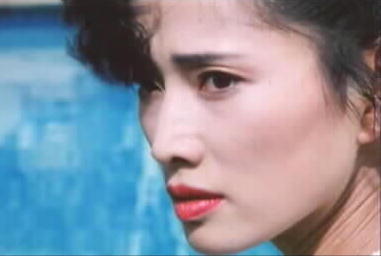


Two contrasting screen personas spanned Michiko’s Asian career. The first, and most familiar, was dangerous, seductive and aggressive, exemplified by her parts in “Princess Madam” (1989) and “Hero Dream” (1993). The second has received less attention and coverage (at least among Western fans of Asian cinema) but actually represents a broader range of acting skill in which Michiko portrayed quite feminine – even vulnerable – characters in such films as “Young Lady Detectives” (1987) or “Passionate Killing In The Dream” (1992).
Although rightly regarded as one of the leading female action actors of her day, all Michiko’s screen characters portray a passionate woman, neither coy nor ascetic. Never displaying any doubt of her attraction to men, in two of her larger roles (“Passionate Killing in the Dream,” 1992; “The Real Me,” 1991) Michiko and her character’s male lover, respectively, reject homosexual advances. Michiko’s acting in many of her parts is as fiercely carnal as it is combative. This may represent another instance of Michiko’s explicit emphasis on femininity in addition to strength.
From her earliest appearances Michiko was cast as an almost perfect femme fatale. Although an accident of physiognomy, her hooded eyelids and sharply sculpted facial features instantly capture attention, hypnotic as one of Tamara de Lempicka’s art deco portraits of bedroom-eyed women. Both soft and hard, Michiko has described deliberately tempering her bodybuilding poses with open-handed stances so as to dilute the impression of aggression. Always presenting such contradictions, Michiko’s characters may display vengeful fidelity to the death - even to an abusive, terminally ill partner (“In The Line of Duty III,” 1988), or oscillate unnervingly between seduction and sadism (“Princess Madam,” 1989). When she has an affair, it’s with exciting stolen moments, accompanied by sudden uninhibited celebration of the carnal - lingering looks alternating with bites that leave marks.
Michiko’s screen relationships have a doomed air. Either she follows her criminal or terrorist partners to their deaths (“Princess Madam,” 1989; “Angel Terminators,” 1990; “In The Line of Duty III,” 1988) or simply sacrifices herself with them (“The Real Me,” 1991), or while fighting for them (“The Dragon Fighter,” 1990). At her most exciting Michiko herself may be both the instrument of lust and death. In “Hero Dream” (1993) Michiko’s character kneads the pectorals of her male partner while in a female superior position - exactly as a man might in a Category III scene. Later she kills another lover - seemingly on a whim.
Michiko probably gained entry to movie parts more because of how she looked in a pose than what she was able to do. As a result Michiko’s characters spend considerable time lounging or posing in bathing suits or nightwear, as well as disrobing completely in several films (“Young Lady Detectives,” 1987; “In The Line of Duty III,” 1988; “Hero Dream,” 1993). As an actor she seemed prepared to perform parts that involved a dominant theme of sexuality. Her male partners might fade in or out as sudden pairings to be aroused or sacrificed for, or as objects to be used. But the central focus - even in her “pink” film (“Young Lady Detectives,” 1987) was always Michiko.
In their sexual involvements her characters range from passionately committed (“The Real Me,” 1991; “In The Line of Duty III,” 1988) to callously narcissistic and exploitative (“Hero Dream,” 1993). In a striking reversal of typical gender roles, Michiko’s aggressively sexual screen characters have either bitten and slapped their partners (“Princess Madam,” 1989; “Hero Dream,” 1993), accepted partner violence (“In The Line of Duty III,” 1988) or suddenly turned the tables. Dangerous unpredictability adds depth to Michiko’s femmes fatales.
Such runaway ruthlessness has been tempered
by plot devices such as depicting her character as frankly deranged or
as a person whose life is not worth living after the loss of her male partner
(“In The Line of Duty III,” 1988). This, in turn, propels her character
toward acts of suicidal vengeance – as in her attempt to take Cynthia Khan’s
policewoman with her to a bomb-laden oblivion. This ultimately weakens
her character by making her behavior subordinate to her male partner.
While he is driven by fanaticism, Michiko’s character dreams about living
on a yacht with the money they have stolen! In such a manner Michiko’s
characters may be brought within the orbit of conventional – hence comprehensible
– gender roles.